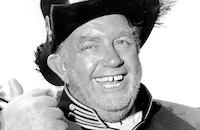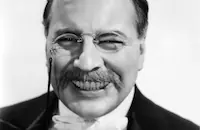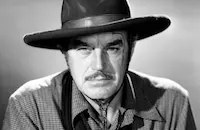The President Vanishes
Cast & Crew
William A. Wellman
Edward Arnold
Arthur Byron
Paul Kelly
Peggy Conklin
Andy Devine
Film Details
Technical Specs

Synopsis
Following the outbreak of war in Europe, President Stanley of the United States takes a non-interventionalist stance in the conflict and disregards congressional pressure to do otherwise. As a result, a secret meeting of some of America's most powerful men is held to discuss the ways in which they can get America involved in the war. The meeting takes place at Washington lobbyist D. L. Voorman's house and is attended by Martin Drew, a wealthy banker; Edward Cullen, a steel magnate who sees great profits in munitions manufacturing; Roger Grant, owner of a chain of newspapers reaching over ten million readers; Mr. Corcoran, a retired judge; and Richard Norton, an oil tycoon. Before the meeting commences, Voorman's wife Sally praises the men, calling them the "eagles who will safeguard America's democracy," and Grant suggests that they adopt her pronouncement as their slogan. The men agree that the headline "saving the country's honor" should be used in newspapers to sway public opinion in favor of American military intervention in the war. Voorman and his co-conspirators soon ally themselves with the Gray Shirts, the foot soldiers of American opposition to President Stanley's policies, whose leader, Lincoln Lee, engages in a nationwide campaign to bring America into the war. Invoking the patriotism of the American people, the Gray Shirts's campaign provokes riots and results in an attack on a pro-pacifist propaganda artist in his studio. With the approach of a critical congressional vote that could overrule the president's decision to stay out of the war, Stanley anticipates that he may be impeached over the matter. When the president is late for his meeting with Congress, it is feared that he has been kidnapped, and an investigation is immediately begun. The investigation results in the roundup of suspects Lincoln Lee, the president's secretary, Harris Brownell, and Val Orcott, a grocery delivery boy who was the last person seen with the president. Secretary of War Lewis Wardell interrogates the suspects and threatens to send the uncooperative Lee to an insane asylum if he does not talk. Wardell strikes Lee for his insolence and continues to attack him until Chick Moffat of the White House Squad intervenes. Later, Chick's sweetheart, Alma Cronin, is contacted by someone bent on subverting Chick's investigation. Alma is offered $10,000 for Chick's diary, but she refuses to accept it and tells Chick about the incident. Meanwhile, Americans begin to focus their attention not on the war but on their concern over the president's whereabouts and safety. Chick tries to set a trap to catch the men who tried to bribe Alma, but he is knocked out when the thugs punch him. While Chick lies unconscious, Alma finds a watch with an inscription that she believes will lead the police to Chick's attackers and perhaps the president's kidnappers. Before Alma is able to call the Secret Service, however, Chick prevents her from doing so by socking her in the jaw. While a nationwide search for the president turns up nothing, Norton manages to secure a war declaration from Vice President Bob Molleson, the man they hope to put in office to replace Stanley. It is then learned that the president, with the aid of Chick, has hidden himself in an empty parking garage where the Gray Shirts usually hold their meetings. Stanley, gagged and bound, has been planted there by Chick to make it look like as if the Gray Shirts were his abductors. Chick tips off the police as to the president's whereabouts, but before the police arrive, Lee drives into the garage, discovers the frame-up attempt, and prepares to kill the president. Chick returns to the garage just in time to save Stanley and shoot Lee. The police arrive and Chick is honored as a hero for having saved the president. Later, Chick explains to Alma that the president saw the need to "do something extraordinary to bring the people back to their senses," so he concocted a plan have himself kidnapped. After returning to the White House, Stanley consents to be Alma and Chick's best man at their wedding and makes a speech reaffirming his opposition to war.

Director

William A. Wellman
Cast

Edward Arnold

Arthur Byron

Paul Kelly

Peggy Conklin

Andy Devine

Janet Beecher

Osgood Perkins

Sidney Blackmer

Edward Ellis
Irene Franklin

Rosalind Russell

Robert Mcwade

Dewitt Jennings

Walter Kingsford
Douglas Wood
Charles Richman

Paul Harvey

Harry Woods
Tommy Dugan
Martha Mayo
Charles K. French
William Worthington
William J. Holmes
Charles Meakin
Art Howard
Ed Lewis
Ed Mortimer
Emmett King
Edgar Sherrod
Henry Herbert
Clara Blandick
Crew
Emanuel Cohen
John F. Dockwieler
Hanson Fritch
Hugo Grenzbach
John Hoffman
Barney Mcgill
Dr. Hugo Riesenfeld
Lynn Starling
Sidney M. Ullman
Slavko Vorkapich
Walter Wanger
Carey Wilson
Cedric Worth
Dolph Zimmer

Film Details
Technical Specs

Quotes
Trivia
Notes
Although the first edition of the novel upon which this film is based, The President Vanishes, was published anonymously, later editions list Rex Stout as the author. The onscreen forward to The President Vanishes notes that "this dramatic episode is in no sense historical. The story and the characters are purely fictional." According to Paramount Press Sheets, however, the story was somewhat topical in light of the contemporaneous U.S. Senatorial investigation of American munitions manufacturers and their conspiracy to promote war in order to bolster arms sales. The file for the film in the MPAA/PCA Collection at the AMPAS Library indicates that in September 1934, the PCA urged Paramount to change the character names of steel corporation head "Andrew Cullen" (possibly Andrew Carnegie) and newspaper publisher "Hartley Grinnell" (possibly Josiah Bushness Grinnell) because of a "similarity to names of well-known persons." Although it has not been determined whether or not Paramount's decision to change the names in question was a result of the PCA's request, the studio changed the names to "Edward Cullen" and "Roger Grant" respectively. The PCA also warned Paramount that "the character now known as Corcoran should not be portrayed as a United States Senator." "Corcoran's" character was later changed to a judge. Perhaps the PCA's strongest objection to the script involved the characterization of "Vice President Molleson." Joseph I. Breen, Director of the PCA, urged producer Walter Wanger to not portray the vice president of the United States as as "a drunkard, a weakling, a fool, an excessively vain man, or as a man who is linked up with crooked politicians and business men in a friendly fashion, consciously or unconsciously condoning their actions or accepting their dictates." He preferred that the film portray the vice president as a "strong character-at least not a 'sap.'" Breen also expressed his apprehension about making the "heavies" in the picture a steel man, an oil man, a banker and a newspaper man, fearing that it would be "resented quite forcefully" and "give the [film] industry no end of trouble." He suggested instead that all four characters be made international munitions men, or that a speech indicating that the men are not typical examples of American newspaper publishers and magnates be inserted into the script.
According to Daily Variety pre-production news items, Walter Wanger, who produced this picture as his first film for Paramount, closed a deal with M-G-M for Lewis Stone to play the President, but later replaced him with Arthur Byron because the former was too well-known, and he was certain that the public would not accept him in the role. The Variety and New York Times reviews incorrectly list Clara Blandick in the part played by Martha Mayo. Daily Variety pre-release news items indicate that, in addition to the twenty-two member cast, the film employed thirty-five stuntmen and two thousand extras. The President Vanishes marked the screen debut of New York stage actress Peggy Conklin. Paramount publicity material also notes that some fifty-one sets were constructed for this film, most of which were exact replicas of famous Washington, D.C. landmarks. Hollywood Reporter pre-release news items note that Paramount was "nervous" about the release of the picture following the hold-up of the PCA certificate of approval. A January 1935 Daily Variety news item notes that many Hearst-owned newspapers around the country were "giving silence to The President Vanishes." Although the papers carried advertisments for the film, they did not print any reviews or publicity relating to the film. A New York Times news item indicates that the film was banned in Jamaica, Venezuela, Germany, Austria, Czechoslovakia, Italy and France. France reportedly rejected the picture because of "continuous political allusions throughout the dialogue."












